Xiaodong Xu
Instance Communication System for Intelligent Connected Vehicles: Bridging the Gap from Semantic to Instance-Level Transmission
Dec 27, 2025Abstract:Intelligent Connected Vehicles (ICVs) rely on high-speed data transmission for efficient and safety-critical services. However, the scarcity of wireless resources limits the capabilities of ICVs. Semantic Communication (SemCom) systems can alleviate this issue by extracting and transmitting task-relevant information, termed semantic information, instead of the entire raw data. Despite this, we reveal that residual redundancy persists within SemCom systems, where not all instances under the same semantic category are equally critical for downstream tasks. To tackle this issue, we introduce Instance Communication (InsCom), which elevates communication from the semantic level to the instance level for ICVs. Specifically, InsCom uses a scene graph generation model to identify all image instances and analyze their inter-relationships, thus distinguishing between semantically identical instances. Additionally, it applies user-configurable, task-critical criteria based on subject semantics and relation-object pairs to filter recognized instances. Consequently, by transmitting only task-critical instances, InsCom significantly reduces data redundancy, substantially enhancing transmission efficiency within limited wireless resources. Evaluations across various datasets and wireless channel conditions show that InsCom achieves a data volume reduction of over 7.82 times and a quality improvement ranging from 1.75 to 14.03 dB compared to the state-of-the-art SemCom systems.
Semantic Radio Access Networks: Architecture, State-of-the-Art, and Future Directions
Dec 24, 2025Abstract:Radio Access Network (RAN) is a bridge between user devices and the core network in mobile communication systems, responsible for the transmission and reception of wireless signals and air interface management. In recent years, Semantic Communication (SemCom) has represented a transformative communication paradigm that prioritizes meaning-level transmission over conventional bit-level delivery, thus providing improved spectrum efficiency, anti-interference ability in complex environments, flexible resource allocation, and enhanced user experience for RAN. However, there is still a lack of comprehensive reviews on the integration of SemCom into RAN. Motivated by this, we systematically explore recent advancements in Semantic RAN (SemRAN). We begin by introducing the fundamentals of RAN and SemCom, identifying the limitations of conventional RAN, and outlining the overall architecture of SemRAN. Subsequently, we review representative techniques of SemRAN across physical layer, data link layer, network layer, and security plane. Furthermore, we envision future services and applications enabled by SemRAN, alongside its current standardization progress. Finally, we conclude by identifying critical research challenges and outlining forward-looking directions to guide subsequent investigations in this burgeoning field.
Parameter-Efficient MoE LoRA for Few-Shot Multi-Style Editing
Nov 14, 2025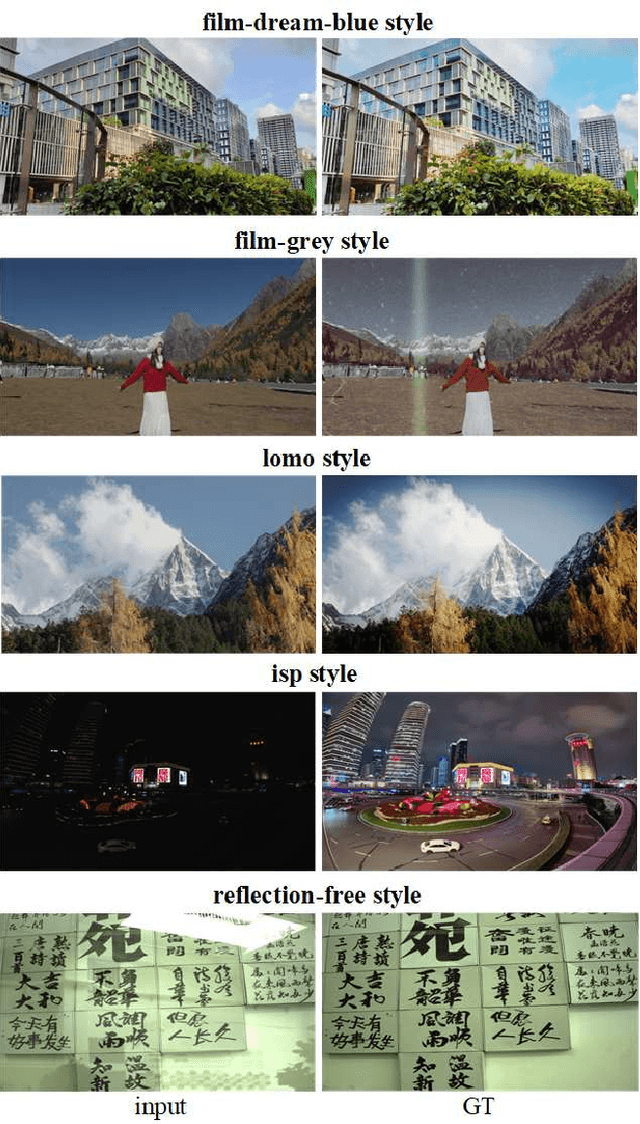
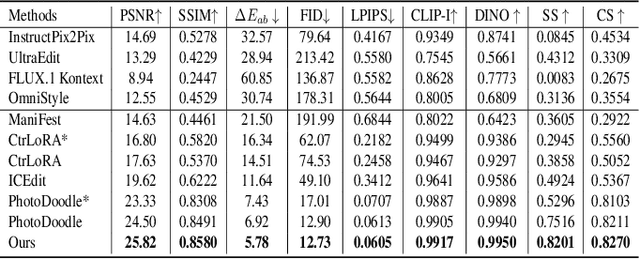
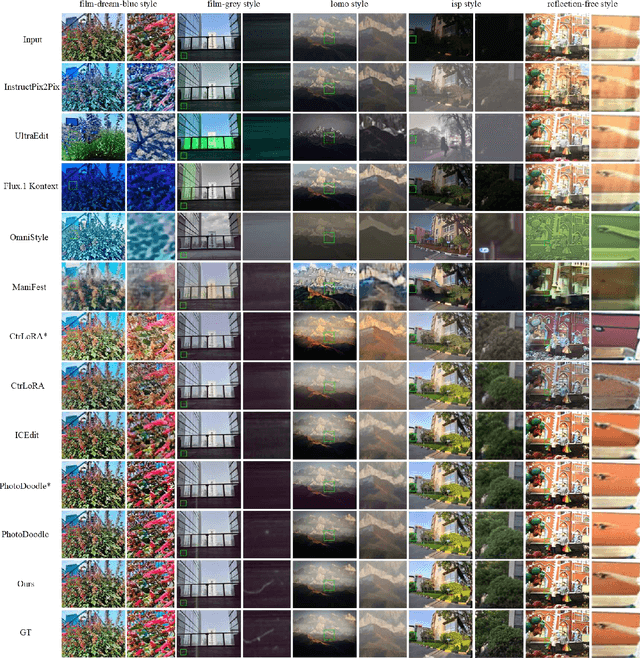
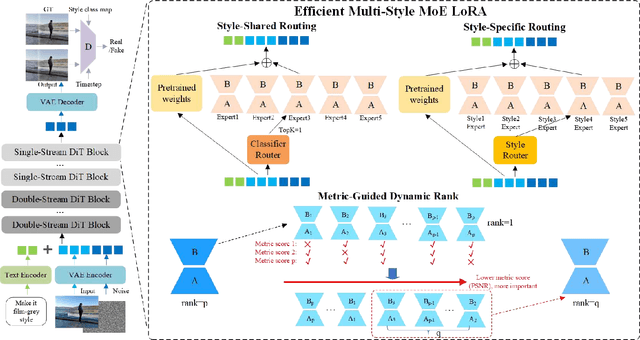
Abstract:In recent years, image editing has garnered growing attention. However, general image editing models often fail to produce satisfactory results when confronted with new styles. The challenge lies in how to effectively fine-tune general image editing models to new styles using only a limited amount of paired data. To address this issue, this paper proposes a novel few-shot style editing framework. For this task, we construct a benchmark dataset that encompasses five distinct styles. Correspondingly, we propose a parameter-efficient multi-style Mixture-of-Experts Low-Rank Adaptation (MoE LoRA) with style-specific and style-shared routing mechanisms for jointly fine-tuning multiple styles. The style-specific routing ensures that different styles do not interfere with one another, while the style-shared routing adaptively allocates shared MoE LoRAs to learn common patterns. Our MoE LoRA can automatically determine the optimal ranks for each layer through a novel metric-guided approach that estimates the importance score of each single-rank component. Additionally, we explore the optimal location to insert LoRA within the Diffusion in Transformer (DiT) model and integrate adversarial learning and flow matching to guide the diffusion training process. Experimental results demonstrate that our proposed method outperforms existing state-of-the-art approaches with significantly fewer LoRA parameters.
Qwen3Guard Technical Report
Oct 16, 2025Abstract:As large language models (LLMs) become more capable and widely used, ensuring the safety of their outputs is increasingly critical. Existing guardrail models, though useful in static evaluation settings, face two major limitations in real-world applications: (1) they typically output only binary "safe/unsafe" labels, which can be interpreted inconsistently across diverse safety policies, rendering them incapable of accommodating varying safety tolerances across domains; and (2) they require complete model outputs before performing safety checks, making them fundamentally incompatible with streaming LLM inference, thereby preventing timely intervention during generation and increasing exposure to harmful partial outputs. To address these challenges, we present Qwen3Guard, a series of multilingual safety guardrail models with two specialized variants: Generative Qwen3Guard, which casts safety classification as an instruction-following task to enable fine-grained tri-class judgments (safe, controversial, unsafe); and Stream Qwen3Guard, which introduces a token-level classification head for real-time safety monitoring during incremental text generation. Both variants are available in three sizes (0.6B, 4B, and 8B parameters) and support up to 119 languages and dialects, providing comprehensive, scalable, and low-latency safety moderation for global LLM deployments. Evaluated across English, Chinese, and multilingual benchmarks, Qwen3Guard achieves state-of-the-art performance in both prompt and response safety classification. All models are released under the Apache 2.0 license for public use.
SREC: Encrypted Semantic Super-Resolution Enhanced Communication
Sep 05, 2025Abstract:Semantic communication (SemCom), as a typical paradigm of deep integration between artificial intelligence (AI) and communication technology, significantly improves communication efficiency and resource utilization efficiency. However, the security issues of SemCom are becoming increasingly prominent. Semantic features transmitted in plaintext over physical channels are easily intercepted by eavesdroppers. To address this issue, this paper proposes Encrypted Semantic Super-Resolution Enhanced Communication (SREC) to secure SemCom. SREC uses the modulo-256 encryption method to encrypt semantic features, and employs super-resolution reconstruction method to improve the reconstruction quality of images. The simulation results show that in the additive Gaussian white noise (AWGN) channel, when different modulation methods are used, SREC can not only stably guarantee security, but also achieve better transmission performance under low signal-to-noise ratio (SNR) conditions.
KGRAG-SC: Knowledge Graph RAG-Assisted Semantic Communication
Sep 05, 2025
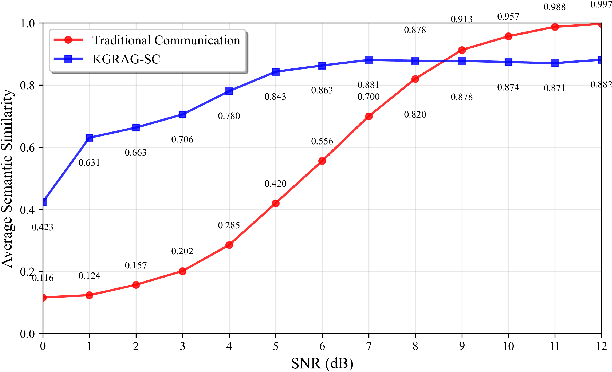
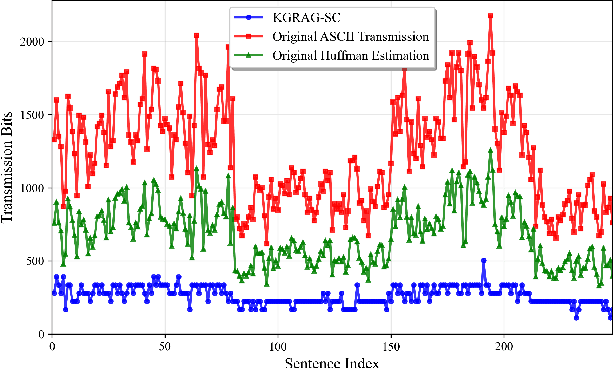
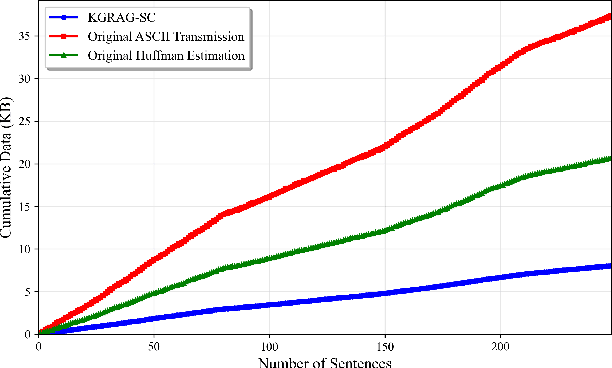
Abstract:The state-of-the-art semantic communication (SC) schemes typically rely on end-to-end deep learning frameworks that lack interpretability and struggle with robust semantic selection and reconstruction under noisy conditions. To address this issue, this paper presents KGRAG-SC, a knowledge graph-assisted SC framework that leverages retrieval-augmented generation principles. KGRAG-SC employs a multi-dimensional knowledge graph, enabling efficient semantic extraction through community-guided entity linking and GraphRAG-assisted processing. The transmitter constructs minimal connected subgraphs that capture essential semantic relationships and transmits only compact entity indices rather than full text or semantic triples. An importance-aware adaptive transmission strategy provides unequal error protection based on structural centrality metrics, prioritizing critical semantic elements under adverse channel conditions. At the receiver, large language models perform knowledge-driven text reconstruction using the shared knowledge graph as structured context, ensuring robust semantic recovery even with partial information loss. Experimental results demonstrate that KGRAG-SC achieves superior semantic fidelity in low Signal-to-Noise Ratio (SNR) conditions while significantly reducing transmission overhead compared to traditional communication methods, highlighting the effectiveness of integrating structured knowledge representation with generative language models for SC systems.
SemSteDiff: Generative Diffusion Model-based Coverless Semantic Steganography Communication
Sep 05, 2025Abstract:Semantic communication (SemCom), as a novel paradigm for future communication systems, has recently attracted much attention due to its superiority in communication efficiency. However, similar to traditional communication, it also suffers from eavesdropping threats. Intelligent eavesdroppers could launch advanced semantic analysis techniques to infer secret semantic information. Therefore, some researchers have designed Semantic Steganography Communication (SemSteCom) scheme to confuse semantic eavesdroppers. However, the state-of-the-art SemSteCom schemes for image transmission rely on the pre-selected cover image, which limits the universality. To address this issue, we propose a Generative Diffusion Model-based Coverless Semantic Steganography Communication (SemSteDiff) scheme to hide secret images into generated stego images. The semantic related private and public keys enable legitimate receiver to decode secret images correctly while the eavesdropper without completely true key-pairs fail to obtain them. Simulation results demonstrate the effectiveness of the plug-and-play design in different Joint Source-Channel Coding (JSCC) frameworks. The comparison results under different eavesdroppers' threats show that, when Signal-to-Noise Ratio (SNR) = 0 dB, the peak signal-to-noise ratio (PSNR) of the legitimate receiver is 4.14 dB higher than that of the eavesdropper.
VQ-VAE Based Digital Semantic Communication with Importance-Aware OFDM Transmission
Aug 12, 2025



Abstract:Semantic communication (SemCom) significantly reduces redundant data and improves transmission efficiency by extracting the latent features of information. However, most of the conventional deep learning-based SemCom systems focus on analog transmission and lack in compatibility with practical digital communications. This paper proposes a vector quantized-variational autoencoder (VQ-VAE) based digital SemCom system that directly transmits the semantic features and incorporates the importance-aware orthogonal frequency division multiplexing (OFDM) transmission to enhance the SemCom performance, where the VQ-VAE generates a discrete codebook shared between the transmitter and receiver. At transmitter, the latent semantic features are firstly extracted by VQ-VAE, and then the shared codebook is adopted to match these features, which are subsequently transformed into a discrete version to adapt the digital transmission. To protect the semantic information, an importance-aware OFDM transmission strategy is proposed to allocate the key features near the OFDM reference signals, where the feature importance is derived from the gradient-based method. At the receiver, the features are rematched with the shared codebook to further correct errors. Finally, experimental results demonstrate that our proposed scheme outperforms the conventional DeepSC and achieves better reconstruction performance under low SNR region.
Generative Diffusion Models for Wireless Networks: Fundamental, Architecture, and State-of-the-Art
Jul 22, 2025Abstract:With the rapid development of Generative Artificial Intelligence (GAI) technology, Generative Diffusion Models (GDMs) have shown significant empowerment potential in the field of wireless networks due to advantages, such as noise resistance, training stability, controllability, and multimodal generation. Although there have been multiple studies focusing on GDMs for wireless networks, there is still a lack of comprehensive reviews on their technological evolution. Motivated by this, we systematically explore the application of GDMs in wireless networks. Firstly, starting from mathematical principles, we analyze technical advantages of GDMs and present six representative models. Furthermore, we propose the multi-layer wireless network architecture including sensing layer, transmission layer, application layer, and security plane. We also introduce the core mechanisms of GDM at each of the layers. Subsequently, we conduct a rigorous review on existing GDM-based schemes, with a focus on analyzing their innovative points, the role of GDMs, strengths, and weaknesses. Ultimately, we extract key challenges and provide potential solutions, with the aim of providing directional guidance for future research in this field.
Adaptive Federated LoRA in Heterogeneous Wireless Networks with Independent Sampling
May 29, 2025Abstract:Federated LoRA has emerged as a promising technique for efficiently fine-tuning large language models (LLMs) on distributed devices by reducing the number of trainable parameters. However, existing approaches often inadequately overlook the theoretical and practical implications of system and data heterogeneity, thereby failing to optimize the overall training efficiency, particularly in terms of wall-clock time. In this paper, we propose an adaptive federated LoRA strategy with independent client sampling to minimize the convergence wall-clock time of federated fine-tuning under both computation and communication heterogeneity. We first derive a new convergence bound for federated LoRA with arbitrary and independent client sampling, notably without requiring the stringent bounded gradient assumption. Then, we introduce an adaptive bandwidth allocation scheme that accounts for heterogeneous client resources and system bandwidth constraints. Based on the derived theory, we formulate and solve a non-convex optimization problem to jointly determine the LoRA sketching ratios and sampling probabilities, aiming to minimize wall-clock convergence time. An efficient and low-complexity algorithm is developed to approximate the solution. Finally, extensive experiments demonstrate that our approach significantly reduces wall-clock training time compared to state-of-the-art methods across various models and datasets.
 Add to Chrome
Add to Chrome Add to Firefox
Add to Firefox Add to Edge
Add to Edge